On the Bench
The SC-1250 is a
switching amplifier,
which means it turns the output voltage on and off very quickly to produce
the musical signal. I
utilized an Audio Control AUX-0025 filter that is designed for use in
testing switching components. It sits between the amplifier output and the
Audio Precision test instrument input. It begins reducing the signal above
20 kHz and rolls off rapidly. Below is a graph showing the frequency
response of a loop through (Audio Precision output connected back to the
input) with and without the AUX-0025 in the circuit. The idea is that
switching amplifiers produce high frequency switching noise above the
audible band that can get into the test circuit and contaminate the results.
It has to be noted that the filter reduces this noise but does not
completely eliminate it.

With the SC-1250 configured for the SC-12
driver, output voltage is restricted to 50 volts RMS. Using an 8 ohm load
(equal to having one SC-12 driver connected), THD+N at 50 volts output was
1.38%.
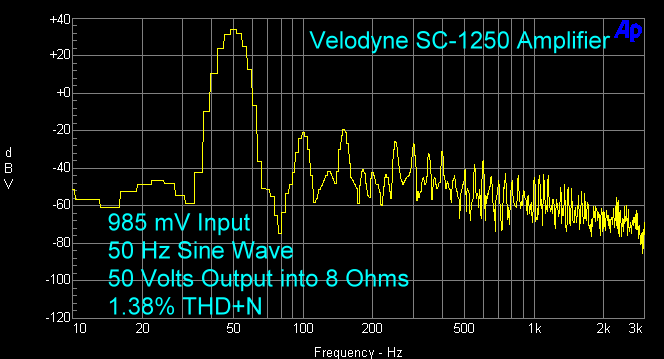
Using a 4 ohm load (equal to having two SC-12
drivers connected), THD+N was 2.82% at 50 volts RMS output. This is rather
high for a power amplifier within its rated output, but I suspect the noise
component of this number - remember, the measurement is THD plus Noise - is
a large percentage of the total value. In any case, I could not hear whatever
distortion was there at low frequencies. That's what makes switching
amplifiers so useful with subwoofers. They deliver high power and run cool,
which is what a subwoofer needs. Also, note that I have tested several
switching amplifiers, and the tendency is towards higher THD+N than typical A/B
amplifiers, so the THD+N measured here is not unusual.

I was able to get 900 watts RMS with a 50 Hz
sine wave into a 4 ohm load before the amplifier shut down.
The following six graphs were taken by placing
our calibrated microphone 1 foot from the front-firing driver of one
enclosure (the second enclosure was not connected for these tests).
At 20 Hz, I could get a maximum of 95 dB
output. THD+N was 10%. This is an acceptable level of distortion from a 12"
driver at 20 Hz, and lower than I thought it might be. Theoretically, a 6 dB increase in
maximum output will be
obtained with a second enclosure placed near the first one, or 3 dB if the
second enclosure is placed somewhere else in the room.

At 25 Hz and 100 dB output, THD+N was
slightly lower, at 9.1%.
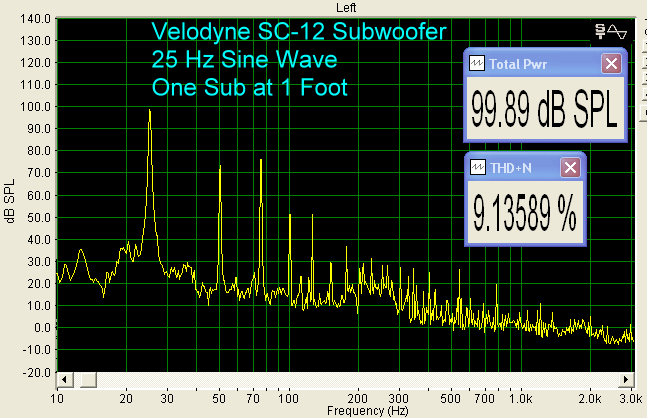
31.5 Hz gave a much lower THD+N.
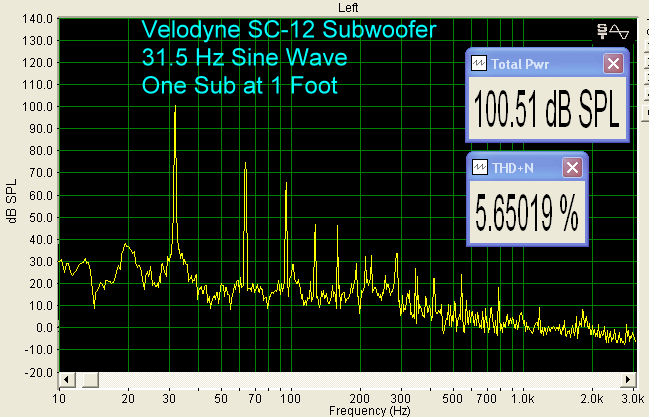
And, at 40 Hz, even lower.

By 50 Hz, THD+N was very low, at 2%.
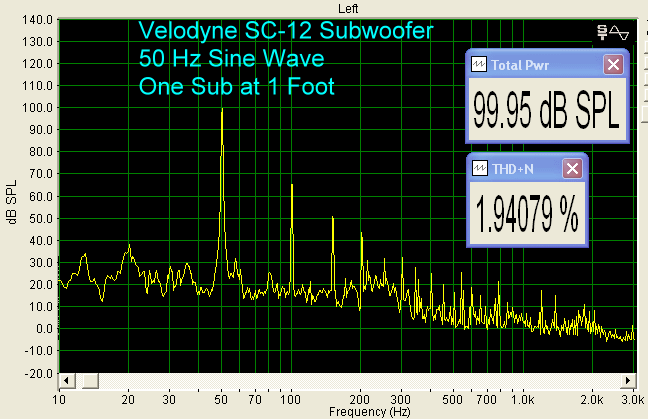
80 Hz is a likely crossover point for many
home theater systems, and at this frequency, THD+N was less than 1%.
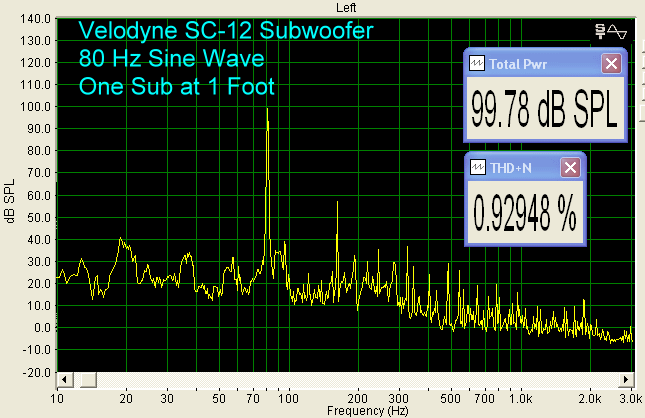
The impedance of the SC-12 driver is well
above 50 ohms for its general operating range of 20 Hz to 65 Hz. The peak at
70 Hz is due to the enclosure resonant frequency. This high impedance means the
amplifier will never have any problems driving it. Note that this is
reactive impedance, not the DC resistive impedance, which measured 8 ohms.
The reactive impedance is high, in part, because of the huge magnet. When
the voltage is AC, such as 20 Hz, the changing electromagnetic field in the
voice coil, produced by the alternating 20 Hz current, is resisted by the
driver's permanent magnet. Velodyne mentioned to me that they designed the drivers with high impedance
so that several of them could be connected to the single SC-1250 amplifier
in parallel.
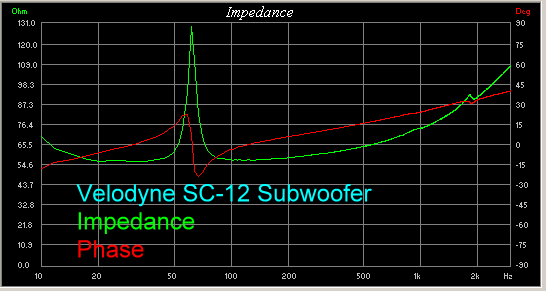
The room response was collected using two
enclosures several feet out from the walls, and 6 feet apart. The microphone
was placed midway between them, 1 meter from each driver, pointing between
them, forming a shallow triangle. The crossover in the amplifier was turned
off for the measurement. The response is flat from 40 Hz to 100 Hz and rolls
off below 40 Hz, but appears to stay close to within the spec of 22 Hz to
120 Hz ± 3 dB.

Conclusions
Velodyne has established a fine product line
in the SubContractor SC series of drivers, all operated with the SC-1250
amplifier.
Coupling sealed enclosures with high impedance
drivers insures the bulletproof setup that custom installers will find very
appealing, but most importantly, will deliver deep, tight bass to consumers
that will continue to play, and play, and play.
- John E. Johnson, Jr. -